
© 2021 OJ Electronics A/S
33
Regulator (C):
The thermostat functions as a simple regulator
and no sensors are used. The setting is in per
cent.
”Regulator” mode in combination with
”Night setback”
If both Regulator mode (APp
a
C) and ”Night
setback” are selected, night setback is set in
relative values while frost protection is set in
absolute values in per cent.
The setpoint specifies (in per cent) the time the
unit is to remain active in a PWM cycle, which
is usually 20 min, while setback degree is
specified as a percentage of the setpoint.
The setpoint multiplied by the setback degree
gives the activation degree.
Example: If the setpoint is set to 60 % and
night setback is set to 25 %, the activation
degree will be (0.60 x 0.25 = 0.15) = 15 %.
Graphic
example:
Setpoint
nSb Setback
nSb Activation
degree
Local
Setpoint
in APP “C”
mode
The diagram should be read as follows:
Furthest to the left is 100 % duration of PWM,
while the vertical lines indicate successive
20 % drops in the time heating is provided
relative to 100 %.
The black area indicates the percentage cut-
out time determined by the setpoint.
Together with the light grey area, the dark grey
area indicates the relative amount of operating
time when nSb has not been activated, but the
dark grey area cuts out when nSb is activated.
The light grey area is the relative amount of
operating time when nSb has been activated
by the above-mentioned values.
The default value of setback degree ”night
setback” (nSb) is 30 %.
nSb is inactive as default.
Frost protection ”dEF” has the specified acti-
vation degree and is unaffected by the setback
degree in nSb.
Scale
Choose between degrees Celsius and a numerical scale. If the
numerical scale is selected, temperature is set on a scale from 0.0
to 10.0 where 0.0 corresponds to min. temperature (SCA
a
Lo) and
10.0 corresponds to max. temperature (SCA
a
Hi).
Temperature reading
Defines which temperature is to be shown on the start display: the
setpoint (SP) or the actual, measured temperature.
Adjust offset
If the actual temperature (measured using a thermometer) differs
from that displayed by the thermostat, the thermostat can be
adjusted to offset the difference.
Control method
PWM or ON/OFF control can be selected. PWM is an advanced
control method which calculates the most effective and economi-
cal way to heat homes and other buildings. ON/OFF control is
traditional differential control (e.g. 0.3 °C) for other tasks.
PWM cycle time
Allows cycle time to be set when using PWM control. At least 20
min is recommended.
ETN4-1999
English
Differential temperature
Allows temperature differential to be set when using ON/OFF con-
trol. The higher the differential temperature, the lower the number
of relay operations.
Relay function
When used for heating purposes, the relay should be in normally
open position (NO). If the thermostat is used for cooling purposes,
the relay should be turned to normally closed (NC).
EN50559
This thermostat complies with EN 50559 (VDE 0705-559) for
electrical floor heating. The regulation applies to electrical floor
heating, with a maximum floor weight of 4 kN/m². To ensure
that hotspots due to unintentionally covering up the surface are
avoided, the heating function can be time-limited as per EN/DIN.
Note that this function is not applicable to other heating applica-
tions such as wall and/or ceiling heating.
If it can be foreseen in advance that unintentional covering up of a
floor might occur, then it is important to assess the correct period
of time for which the floor heating must be time-limited.
The heating can be limited using a set number between 0 - 20
minutes per hour.
Example:
If obstacles could be present that cover up the floor, then the heat-
ing might need to be limited by some number of minutes so as to
avoid hotspots in the floor.
If you want the thermostat to heat a maximum of 90 % of the time,
then the thermostat should be limited by 10 %.
Ten percent of one hour is 6 minutes.
Enter 6 min. in the EN50559 menu in order to lower the heating by
10 %.
Equation to calculate number of minutes that could be entered in
the EN50559 menu - when an average heating effect is desired:
Average wanted heating effect pr. m
2
Floor heating element effect pr. m
2
(
1-
(
)
)
∗
60 min.
Note! If the result of the equation is negative, then nothing should
be entered.
Software version
Displays thermostat software version.
TROUBLESHOOTING
Factory reset
Allows factory settings to be restored. Your personal settings will
be deleted from the thermostat.
Press and hold the centremost button for 10 seconds. The display
is switched off and then on again. Application is shown on the
display (APp
a
F) followed by the temperature setting.


































